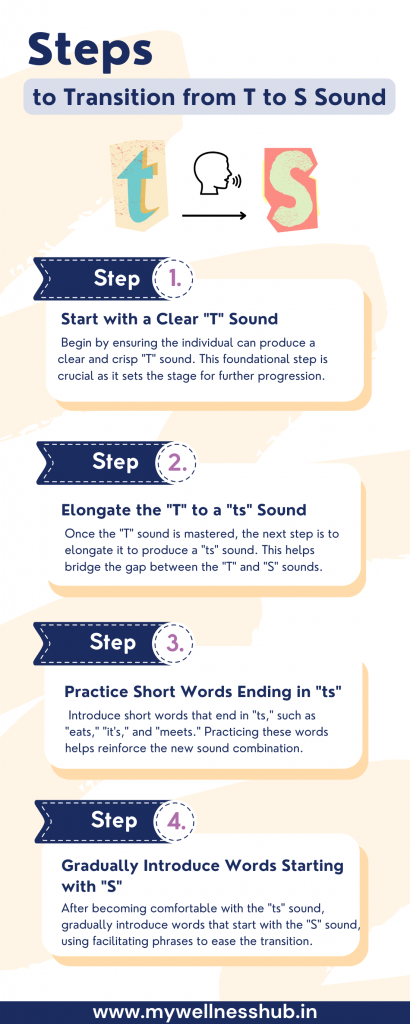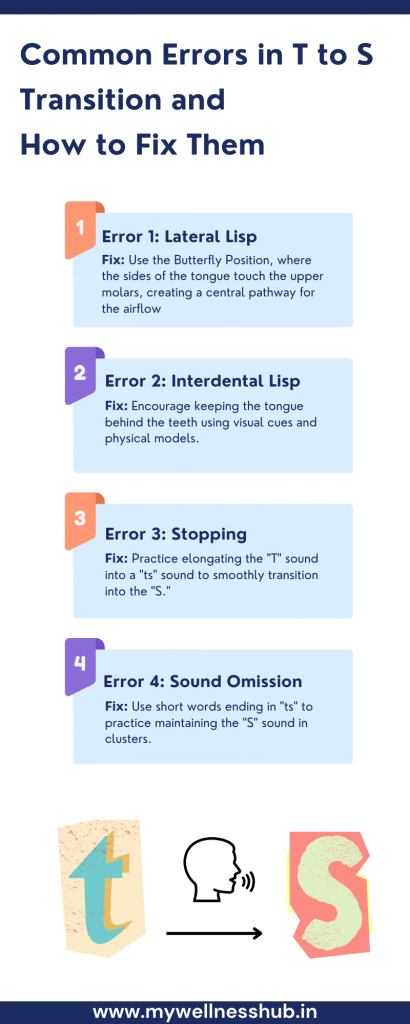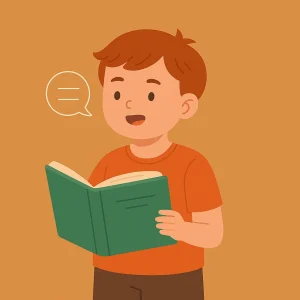Effective T to S Speech Therapy Techniques for Clearer Speech
Last Updated: September 5, 2024
Clear speech is essential for effective communication, helping us express ourselves and connect with others. Whether it’s for social interactions, academic success, or professional achievements, the ability to articulate sounds correctly plays a vital role. However, some sounds can be tricky to master, and the transition from the “T” sound to the “S” sound is one of those challenges.
In speech therapy, transitioning from “T” to “S” can be particularly difficult due to the subtle differences in tongue placement and airflow. This article will guide you through effective techniques to help you or your child achieve clearer speech by mastering this transition. By focusing on practical, easy-to-follow methods, we aim to make this journey smoother and more successful.
Understanding the T to S Transition
Transitioning from the “T” sound to the “S” sound in speech therapy involves understanding the shared features and subtle differences between these sounds. Both “T” and “S” are produced by placing the tongue near the roof of the mouth, just behind the upper front teeth. However, the key difference lies in how the air flows and how the tongue is positioned during the production of these sounds.
Shared Features Between “T” and “S” Sounds:
- Tongue Placement: Both sounds require the tongue to be placed near the roof of the mouth.
- Voiceless Sounds: Both “T” and “S” are voiceless sounds, meaning they are produced without vibrating the vocal cords.
- Front of the Mouth: Both sounds are articulated at the front of the mouth, making them easier to transition between.
Differences Between “T” and “S” Sounds:
- Airflow: The “T” sound is a stop sound, where the airflow is briefly stopped by the tongue and then released. In contrast, the “S” sound is a fricative sound, where the air flows continuously through a narrow passage created by the tongue and the roof of the mouth.
- Tongue Position: For the “T” sound, the tongue touches the roof of the mouth completely before releasing. For the “S” sound, the tongue creates a small groove, allowing the air to pass through continuously.
Mastering this transition is crucial for clearer speech. It not only improves articulation but also enhances overall communication skills. Effective speech therapy techniques can help individuals, especially children, overcome common errors and achieve this transition smoothly.
Also read: Help Child Master /s/ Sound: Fun Activities & Pro Tips

Starting with the “T” Sound
The journey to mastering the “S” sound begins with ensuring a solid foundation in producing the “T” sound. Here’s how you can get started:
Ensure the Individual Can Produce a Clear “T” Sound
- Start Simple: Ask the individual to say the “T” sound. Ensure that they can produce it clearly and correctly. The tongue should touch the roof of the mouth just behind the upper front teeth.
- Build Confidence: Praise and encourage them when they produce the sound correctly. Positive reinforcement helps build confidence and motivates them to continue practicing.
Read more: The Importance of Consistency in Online Speech Therapy
Making the Long “T” Sound
Once the “T” sound is established, the next step is to elongate it to create a “ts” sound, which serves as a bridge to the “S” sound.
- Encourage Elongation: Ask the individual to make a “T” sound but to blow air for a longer period, turning it into a “ts” sound. Demonstrate this yourself by making an elongated “T” sound.
- Use Visual Cues: Illustrate the length of the sound using visual cues. For example, run your finger along a piece of paper or move your hand from one side to the other to show the sustained sound.
- Practice and Reinforce: Have the individual practice this long “T” sound multiple times. Reinforce their efforts with praise and encouragement to build their confidence and consistency.
Transitioning to the “S” Sound
With practice, the individual can begin transitioning to the “S” sound using short words and facilitating phrases.
- Introduce Short Words: Start with words ending in “ts” like “eats,” “it’s,” and “meets.” These words naturally blend the “T” and “S” sounds, making the transition easier.
- Facilitating Phrases: Gradually introduce words starting with “S” using phrases like “let’s see,” “eats some,” and “meets Sam.” These phrases help the individual get used to the “S” sound at the beginning of words.
Using Visual and Auditory Cues
Visual and auditory cues can significantly enhance the learning process.
- Use Mirrors: Have the individual watch themselves in a mirror while producing the sounds. This helps them see their tongue and mouth movements.
- Demonstrate with Videos: Show YouTube videos or use mouth puppets to demonstrate the correct positioning and airflow. Visual aids make it easier to understand and replicate the sounds.
Practicing with Fun Associations
Making practice enjoyable can lead to better engagement and quicker learning.
- Associate with Fun Sounds: Associate the “S” sound with a snake’s hiss. Use toys, drawings, or even your finger moving like a snake to reinforce this association.
- Play Games and Read Books: Engage in activities that incorporate the “S” sound, such as playing games like “Rattlesnake Jake” or reading books like “Silly Sally.” Fun, motivating activities make practice more enjoyable and effective.
Addressing Common Errors

It’s common to encounter specific errors when transitioning from “T” to “S.” Here are techniques to address them:
- Lateral Lisp: Teach the “Butterfly Position.” Ask the individual to make an “i” sound (as in “tin”), which positions the tongue correctly. Then transition to the “S” sound while maintaining this tongue position.
- Interdental Lisp: Use visual models to keep the tongue behind the teeth to avoid producing a “TH” sound. Demonstrate the correct positioning and have the individual practice it.
Common Errors
| Error Type | Description | Fix |
|---|---|---|
| Lateral Lisp | Air escapes over the sides of the tongue | Use the Butterfly Position to centralize airflow. This involves creating a groove down the center of the tongue while the sides of the tongue touch the teeth. Practice this position to ensure the air flows through the middle. |
| Interdental Lisp | Tongue protrudes between teeth | Keep the tongue behind the teeth and use visual cues to correct the placement. Using a mirror to monitor tongue position can help ensure it stays behind the teeth when producing the “S” sound. |
| Stopping | Substituting “T” for “S” | Practice elongating the “T” sound to create a “ts” sound. This helps in transitioning from the “T” sound to the “S” sound by extending the airflow and practicing the correct tongue placement. |
| Sound Omission | Leaving off “S” in consonant clusters | Use short words ending in “ts” like “eats,” “it’s,” and “meets” to practice including the “S” sound in consonant clusters. Emphasize the “ts” ending to reinforce the correct pronunciation. |
Practicing Regularly for Success
To achieve success in transitioning from the “T” sound to the “S” sound, consistent daily practice is crucial. Regular practice not only reinforces the techniques learned but also helps in building muscle memory, making the correct production of the “S” sound more automatic over time.
The Importance of Consistent Daily Practice
- Reinforcement: Practicing daily helps reinforce the correct tongue placement and airflow needed for the “S” sound. Repetition is key to mastering any new skill, and speech sounds are no different.
- Building Muscle Memory: Just like learning to ride a bike or play an instrument, the muscles involved in speech need consistent training. Daily practice helps in building the muscle memory required for correct articulation.
- Boosting Confidence: Regular practice sessions can significantly boost confidence. As the individual notices improvements, they become more motivated to continue practicing, leading to even better results.
Long-Term Benefits of Regular Practice for Clearer Speech
- Improved Communication: Clear speech enhances overall communication skills, making interactions with others more effective and enjoyable.
- Academic and Professional Success: For children, clear speech can improve participation and performance in school. For adults, it can enhance professional interactions and opportunities.
- Social Confidence: Being able to speak clearly boosts social confidence. It reduces the frustration that comes with being misunderstood and helps individuals express themselves more freely and effectively.
Daily Practice Schedule
| Day | Exercise | Duration | Notes |
|---|---|---|---|
| Monday | Elongate “T” to “ts” sound | 10 minutes | Use visual cues like sliding a finger along a piece of paper to illustrate the length of the sound. Repeat several times to reinforce the technique. |
| Tuesday | Practice short words ending in “ts” | 10 minutes | Focus on words like “eats,” “it’s,” and “meets.” Emphasize the correct pronunciation by breaking the words into syllables if needed. |
| Wednesday | Mirror practice with “S” sound | 10 minutes | Use a mirror to watch tongue and mouth movements. Ensure the tongue is in the correct position and that the airflow is continuous. |
| Thursday | Play sound association games | 15 minutes | Engage in fun activities using toys or drawings that emphasize the “S” sound, such as associating it with a snake’s hiss. |
| Friday | Practice facilitating phrases | 10 minutes | Use phrases like “let’s see” and “eats some” to practice the “S” sound in context. Gradually move to standalone words starting with “S.” |
| Saturday | Address specific errors (e.g., lateral lisp) | 15 minutes | Use techniques like the Butterfly Position for lateral lisps. Practice specific exercises tailored to correct the individual’s errors. |
| Sunday | Review and fun activities | 20 minutes | Combine all practiced techniques into engaging games like “Rattlesnake Jake” or interactive storytelling. Reinforce the week’s learning in a fun way. |
Know more: Help Your Child Master the /r/ Sound (Easy Tips!)
Conclusion
Mastering the transition from the “T” sound to the “S” sound in speech therapy can be tough but rewarding. By understanding how these sounds are similar and different, starting with a clear “T” sound, stretching it to a “ts” sound, and gradually moving to the “S” sound, you can improve speech clarity. Using visual and auditory cues, making practice fun, and addressing common errors are all helpful strategies. Regular daily practice is crucial for reinforcing these techniques and building muscle memory, leading to clearer speech over time.
If progress is slow or difficult, getting help from a speech therapist can provide personalized guidance. At Wellness Hub, we offer comprehensive speech therapy services to help you reach your speech goals. Our experts are here to support you every step of the way. For more information and resources, visit our online speech therapy services. With dedication and consistent practice, you can overcome speech challenges and enjoy clearer communication.
Frequently Asked Questions:
1. What is T to S Speech Therapy?
T to S Speech Therapy involves a series of techniques and exercises aimed at helping individuals transition from pronouncing the “T” sound to the “S” sound. This type of therapy is essential for those who struggle with articulation issues, ensuring that they can speak more clearly and effectively. The process typically includes exercises that elongate the “T” sound to gradually shift it into an “S” sound, improving overall speech clarity.
2. Why is transitioning from T to S important in speech therapy?
Transitioning from the “T” sound to the “S” sound is crucial because it directly impacts speech clarity. Clear articulation of the “S” sound is essential for effective communication in everyday life, whether at home, school, or work. Mastering this transition helps prevent misunderstandings and boosts confidence in social and professional interactions, contributing to better academic performance and stronger social connections.
3. How can I help my child produce a clear T sound?
To help your child produce a clear “T” sound, start by demonstrating the sound yourself. Encourage them to place their tongue against the roof of their mouth, just behind the upper front teeth, and release a burst of air. Practice this sound repeatedly, offering praise and encouragement for their efforts. Consistent practice helps build muscle memory and confidence, making it easier for them to produce the sound correctly.
4. What are some effective techniques for transitioning from T to S?
Effective techniques for transitioning from “T” to “S” include:
- Elongating the T Sound: Encourage your child to extend the “T” sound by blowing air longer, creating a “ts” sound.
- Visual Cues: Use visual aids such as moving your finger along a piece of paper to illustrate the length of the sound.
- Short Words: Practice with short words that end in “ts” like “eats,” “it’s,” and “meets” to help blend the sounds naturally.
- Facilitating Phrases: Use phrases like “let’s see” and “eats some” to introduce the “S” sound at the beginning of words.
5. How often should my child practice T to S speech therapy exercises?
Daily practice is essential for success in T to S Speech Therapy. Consistent practice helps reinforce the correct techniques, build muscle memory, and ensure that the sounds are produced correctly and automatically over time. Aim for short, focused practice sessions each day to keep your child engaged and motivated.
6. What visual and auditory cues can help with T to S transition?
Visual and auditory cues are highly effective in T to S Speech Therapy. Using mirrors allows your child to watch their own mouth movements and make necessary adjustments. Demonstrating correct positioning with YouTube videos or mouth puppets can also provide a clear visual model. Additionally, using visual aids like running your finger along a piece of paper to show the elongation of the sound can help reinforce the technique.
7. How can I make speech therapy practice fun for my child?
Making speech therapy practice fun can significantly increase your child’s engagement and motivation. Associate the “S” sound with a snake’s hiss and use toys, drawings, or finger movements to mimic a snake. Incorporate games like “Rattlesnake Jake” or reading books like “Silly Sally” that emphasize the “S” sound. Engaging activities make practice enjoyable and help reinforce the learning process.
8. What should I do if my child has a lateral lisp?
If your child has a lateral lisp, you can help by teaching the “Butterfly Position.” Have your child make an “i” sound (as in “tin”), which positions the tongue correctly with a groove down the center and the sides touching the teeth. Then, transition to the “S” sound while maintaining this tongue position. This method helps correct the airflow and tongue placement issues associated with a lateral lisp.
9. How can a speech therapist help with T to S transition?
A speech therapist can provide personalized guidance tailored to your child’s specific needs. They can assess your child’s current abilities, identify any specific challenges, and develop a customized therapy plan. Regular sessions with a speech therapist ensure consistent progress, as they can monitor your child’s development, adjust techniques as needed, and provide expert support throughout the process.
10. Where can I find more resources on T to S Speech Therapy?
For more resources and professional guidance on T to S Speech Therapy, visit our online speech therapy services at Wellness Hub. We offer a range of resources, from detailed guides to personalized therapy sessions, to help you or your child achieve clearer speech. Explore our speech therapy resources for additional information and support.
About the Author:
Anuradha Karanam
Speech-language pathologist (7+ years of experience)
Anuradha Karanam is a skilled speech-language pathologist with over 6 years of experience. Fluent in Tamil, Telugu, Hindi, and English, she specializes in parent counseling, speech sound disorders, fluency assessment, and speech-language evaluations. Anuradha excels at working with children with developmental disorders, offering creative and effective therapy programs. Currently, at Wellness Hub, she holds a BASLP degree and is registered with the RCI (CRR No A85500). Her patience, ambition, and dedication make her a trusted expert in her field.
Book your Free Consultation Today
Parent/Caregiver Info:
Client’s Details:
* Error Message









